Digital strategy
Giving Tuesday 2024 Final Report : Sustained Acquisition, SMS, & Mission-Centered Creative
December 2024 is delivering a breathless year-end season to nonprofit fundraisers. With Giving Tuesday falling as late as possible on the calendar, we’re looking to the results from early December campaigns for key learnings while simultaneously gearing up for critical end-of-year efforts. Still, it’s worth it to pause and take in what we know so far. What did giving look like across the nonprofit space? What familiar trends emerged, and what surprised us? How can we take these learnings into any last-minute calls at year-end, and even more impactfully, how can we use them to drive growth in 2025?
There are plenty of Giving Tuesday analyses out there, and we’re grateful for the time you spend with ours. We partner with nonprofits of all sizes, across sectors, and while this report is inclusive of all of their results, it is heavily influenced by results from the nonprofits with which we most work: those among the 200 biggest in the country. Other analyses are framed around giving to a great number of smaller, local organizations and universities, among others.
This year, whether nonprofits achieved year-over-year growth or saw their revenue affected by ongoing challenges in the giving landscape, one data point that’s been the subject of industry conversation this year is an increase in donor value – across our nonprofit partners, we saw an average gift of $94 for Giving Tuesday campaigns.
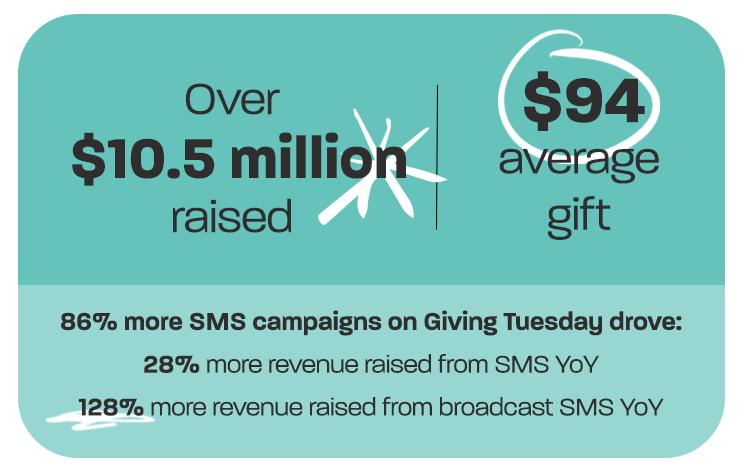
For the nonprofits we serve, each year’s learnings are seismic, with impacts that continue to reverberate for years to come. On Giving Tuesday this year, organizations overly reliant on single channels, like email, struggled to overcome the significant headwinds facing nonprofit fundraisers, namely persistent inflation and a presidential election that consumed billions of dollars in cause-based giving. At the same time, organizations that made bets on sustained acquisition and differentiation stood out. That differentiation looked like SMS programs, sophisticated social advertising and acquisition strategies, bold creative, and dedicated commitments to upgrading supporters to become sustainers and beyond. These were learnings that we highlighted in our 2023 Giving Tuesday Report – from which we were able to build intentional strategies with our partners in 2024. Nonprofits that took note of those trends to diversify across channels saw the benefits in their results this year.
In this year’s report, we’ll dig into the history of average gift amounts, the impact of mid-level campaigns, and the importance of donor retention. We’ll also talk about a key opportunity for 2025: bringing new donors into your file to support the long-term health of your program. And of course, we’ll dig into this year’s giving trends across time and channels and share the top-performing creative strategies that drove response.
At MissionWired, we’re honored to partner with more than 60 nonprofits of all sizes and sectors that are doing incredible work in their communities. And this year we’re thrilled to congratulate them for raising more than $10.5 million this Giving Tuesday – critical revenue that will have an incredible impact in fights against hunger, gun violence, and climate change, campaigns for domestic and international aid, and work to support health and education. We’re grateful every day to get to be a part of their team in supporting their world-changing work.
Now let’s dive into the trends and takeaways!
1. Average gift amount took a significant leap this year.
Over recent years, we’ve seen average gift ticking steadily upward, with bigger surges occurring in 2020 and 2022. This year’s increase in average gift was the biggest yet, coming in at $94.
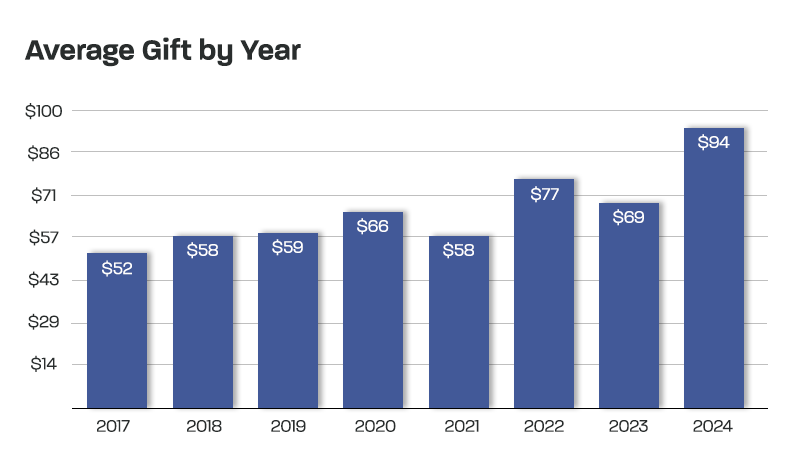
This significant increase in donor value across the industry is an important indicator of your core supporters’ commitment to your work – still, paired with a decline in total number of donors, this trend places an extra amount of pressure on donor retention. In 2025, treating your donors exceptionally well and caring for them with donor retention and cultivation strategies will be critical for building lasting connections with your supporters. Continue to prioritize reminding them why your mission matters and the direct impact of your work in your community.
2. From previews to extensions to evening resends, remaining nimble and responding to results in real time paid off.
While results by time of day varied from one organization to the next, a number of our partners saw some slowness in response early in the day, followed by an increase in revenue from end-of-day sends and extension messages. As in years past, strategies like early access to matches and match extensions that offer donors more time to give helped organizations reach their fundraising goals and took the pressure off of a single day. But organizations who were poised to respond to the ups and downs of the day saw an even greater boost in results.
After tracking a slow start to their morning response rates, one of our nonprofit partners increased their evening sends to close the gap – and saw two unplanned resend and forwarded messages in the evening raise 33% of their email revenue on Giving Tuesday.
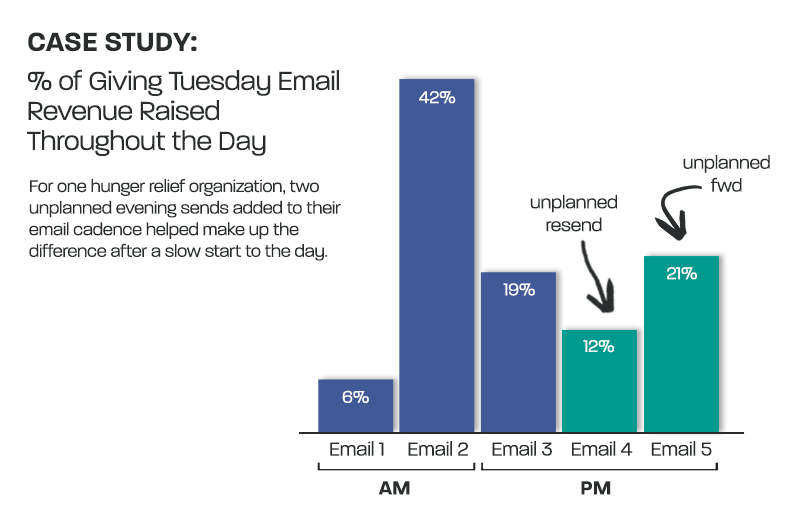
3. Dedicated mid-level campaigns drove increased impact on Giving Tuesday.
Nonprofits that prioritized a thoughtful segmentation strategy at year-end to appeal directly to mid-level donors and prospects saw their efforts pay off in significant increases. One of our partners saw a 43% increase in revenue from their mid-level audience, as well as a 7% increase in gifts from mid-level donors during the Giving Tuesday campaign.
To drive growth to your mid-level program and holistically strengthen your entire donor pipeline, consider segmentation strategies that help you get the most optimal ask in front of each donor, test your assumptions around messaging cadence, and be sure to have a strong stewardship program in place for your mid-level donors.
4. Investments in audience growth helped organizations scale up on Giving Tuesday – and are critical for the long term.
By investing in The Digital Co-Op to grow their audiences ahead of Giving Tuesday, a number of members saw significant payoff on the day. Several members saw more than 40% of their email revenue come from Co-Op delivered leads – and for one member, this portion of their email donors was over 70%.
While a high average gift is evidence that your existing audience is showing up in majorly impactful ways, continuing to acquire new low-dollar donors and mid-level prospects is critical to the long-term health of your program. There are audiences and communities that you’re not yet connecting with and people with an interest in your work you’re not yet asking to support your cause. By investing consistently in acquisition, you can keep the door open to find and engage the supporters who will become your next sustainers and mid-level donors.
And these investments pay off massively in key moments like Giving Tuesday, too – across the board, The Digital Co-Op helped raise $2.3 million from this year’s Giving Tuesday campaigns.
5. Channel diversification supported overall growth in a crowded email environment.
We’ve tracked a steady increase in email volume on Giving Tuesdays over recent years – alongside steeper competition from e-commerce organizations in inboxes – and this year was no different. But the impact of crowded inboxes was felt, with many organizations seeing softer response on email than in years past. For these organizations, the key to a strong Giving Tuesday was never putting all eggs in one basket: Nonprofits that diversified across channels were able to expand their outreach to connect with donors in the channels where they are most active, despite a soft year for email.
While results varied from one organization to the next, for some, scaling up over paid advertising had a major impact on their total revenue – so much so that overall across our clients, paid advertising revenue increased 47% year over year. For others, moving into SMS made the difference: With an 86% increase in text campaigns on Giving Tuesday across our partners, we saw a 28% increase in SMS revenue overall, with an incredible 128% growth in revenue over broadcast SMS.
For one of our nonprofit partners, despite seeing a 10% decrease in email revenue year over year, a significant increase in SMS and ads revenue more than made up the difference, helping them achieve 17% year-over-year growth overall from their Giving Tuesday campaigns.
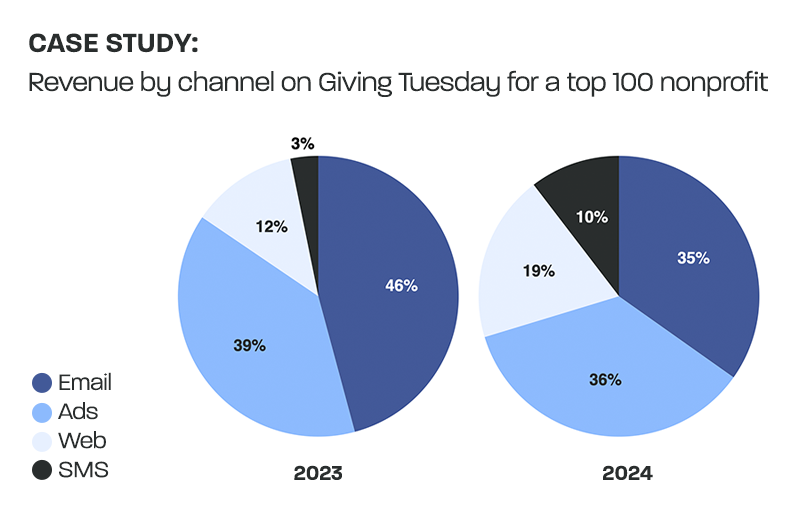
6. Top-performing campaigns told powerful stories of mission and impact.
When nonprofits tell compelling stories about their work and mission, and make the impact of a donor’s gift crystal clear, we see time and again that these are the emails, ads, and texts that drive the highest response. This year’s top-performing campaigns across our nonprofit partners shared their program’s history, told stories of impact, and used dynamic creative content to move and motivate their audiences.
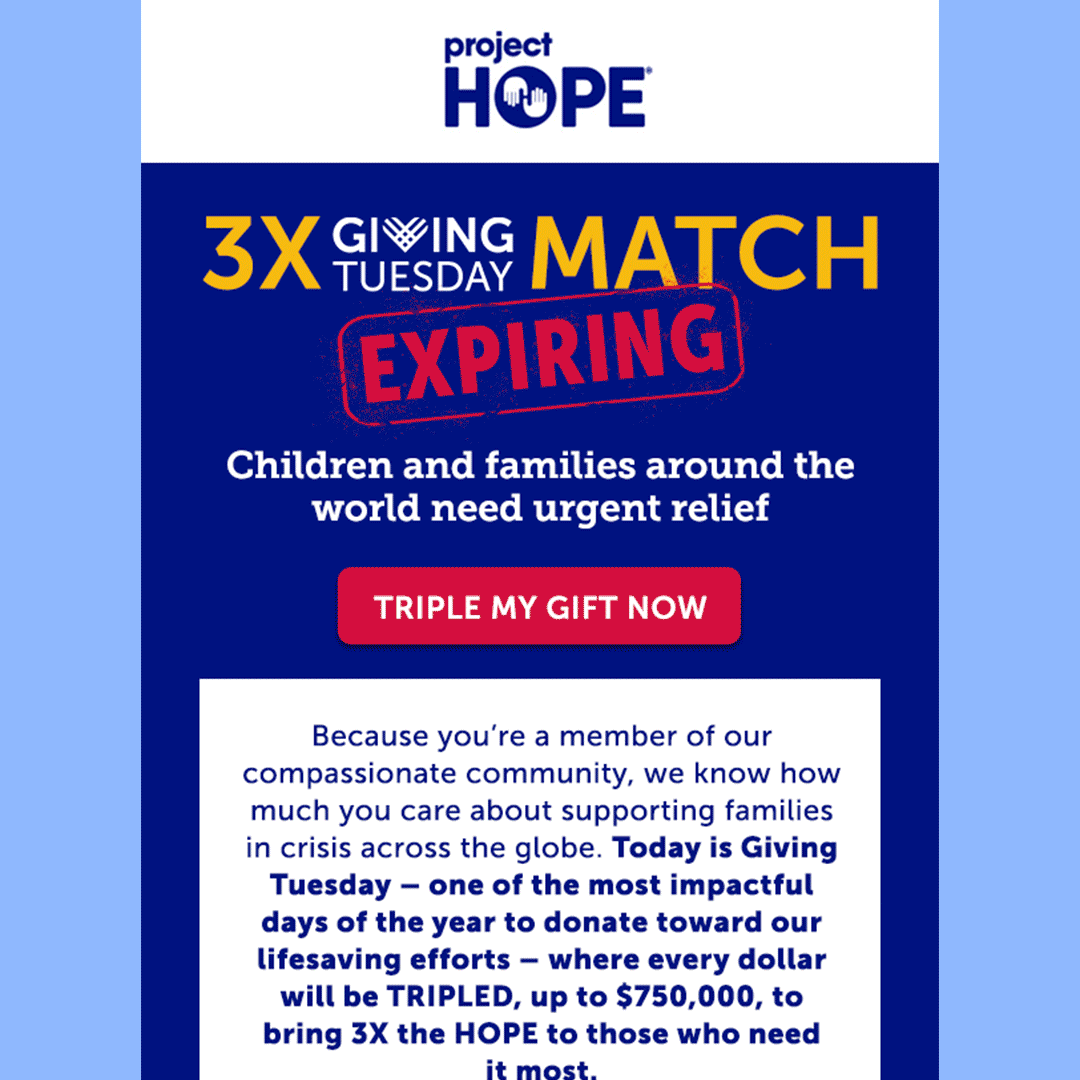
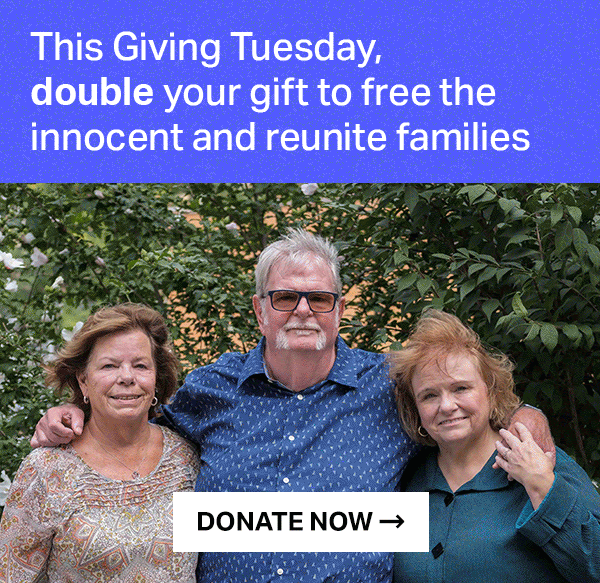
7. And three creative tactics drove connection, urgency, and response.
We always recommend testing to discover the creative strategies that drive response with your unique audience ahead of major moments. This Giving Tuesday, top-performing content utilized several tactics to drive clicks and donations.
Illustrate the increased impact of matches
When a matching gift opportunity is available, many organizations have found that emphasizing match language in creative campaigns can help drive stronger response. And for some nonprofits, telling a story that illustrates the increased impact that a match can have on a donor’s gift can boost response even further.
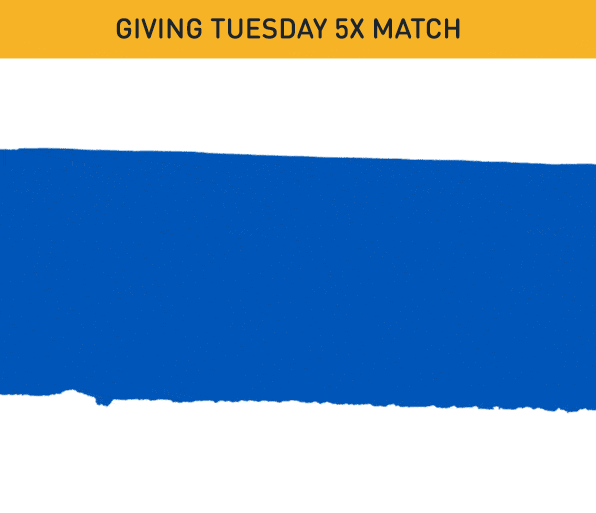
Americares
Emphasize deadlines and match expirations
Urgency-driving tactics like deadlines, countdown clocks, thermometers, and even missed goal messaging have helped make late-in-day sends and next-day messages successful.
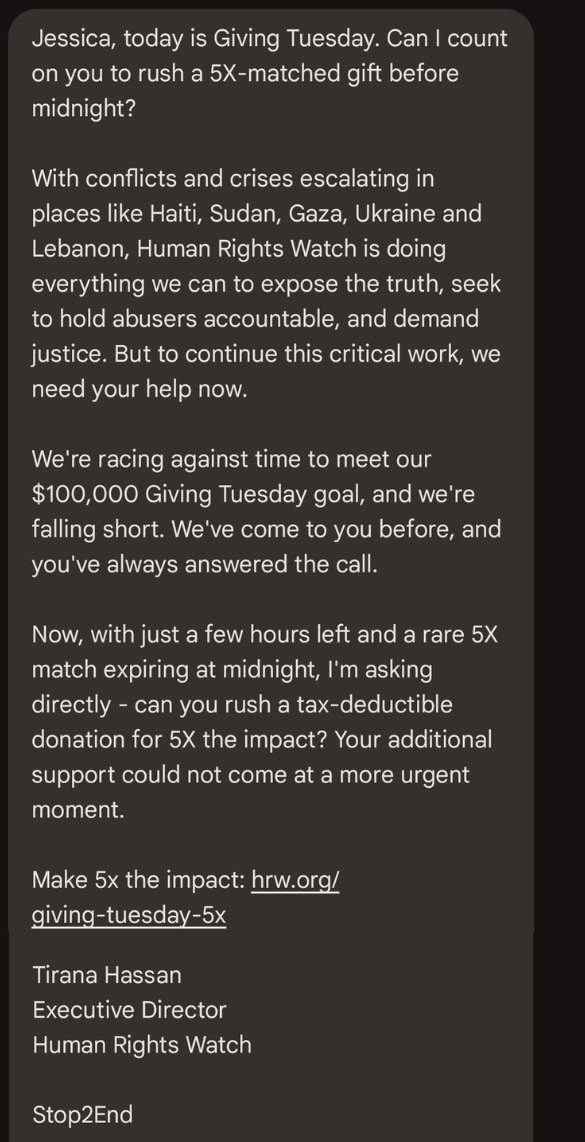
Human Rights Watch
Leverage well-known organizational voices
When a leader within your organization has strong name recognition, it can be powerful to utilize their voice to speak directly to donors. From recorded voice memos in ads to direct-to-camera GIFs, campaigns that put their well-known leaders front and center on Giving Tuesday performed well for several of our partners.
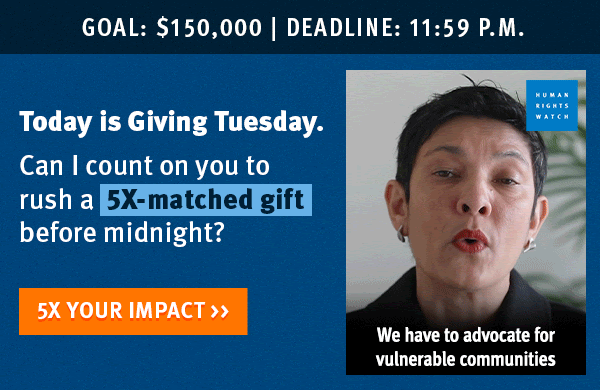
Human Rights Watch
The power of standout creative is something we cannot emphasize heavily enough – because when you take the time to find the kinds of messages that connect your supporters with your core mission, inspire them to take action, and engage them with your world-changing work for the long term, the impact is tremendous. We see this every year – but it’s especially acute in years like this one, when fundraisers are facing a variety of significant challenges all at once. Inclusive, compelling storytelling is so much more than a strategy to build a top-performing message in a single campaign; it’s a touchpoint in each and every one of your donors’ life-long journeys with your organization and its work.
![]()
With End of Year just weeks away, we hope these results and trends offer a broader context for your own data, a few ideas you still have time to leverage this year-end (think: same-day resends and forwards), and some broader themes and holistic approaches to think about going into the new year.
We can’t wait to talk more about how to apply these learnings to your next campaign. And – stay tuned for our annual report in January, with all the need-to-know trends and takeaways over Giving Tuesday and EOY. Share your email below to get these insights and more delivered right to your inbox.
Have an insight or result from Giving Tuesday you’d like to share – or just looking to chat about the tactics outlined here? Get in touch by sending us a note at [email protected].
Next insight